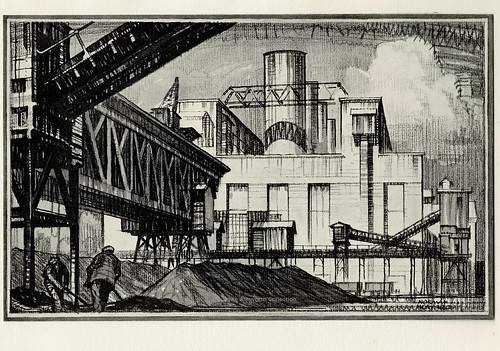Barking's First Power Station by Eric Feasey
I am an older member of the Barking Heritage group and I find working with the younger members extremely interesting - I have not had the time to get worried about the lockdown and viruses.
It is nice to see Valence Local Studies Library is open again, so you too can research into your family tree with the help of very nice people there. I first became interested in local history when I visited Valence House many years ago. One of my main interests is Barking's earliest power station, which can be seen behind a couple of the churches in old pictures of Barking.

The Chimney of the Electric Works behind Barking Broadway from 1897-1927
The new councilors at the 1893 Public Offices (later Magistrate’s Court and now apartments, on East Street) made the dynamic decision, to bring electricity to Barking, at the end of the Victorian era. They instigated the building of the first electrical works or power station in 1897 and chose Thames Electrical Engineers (possibly linked to the famous Ironworks) to install the generators, because they were well established in putting electrical generators into boats.

Electric Cable Stores on the Goad Plans
One of the main reasons for initiating electricity in Barking (beside public lighting) was for a new tram service to Beckton Gas Works, where many Barking people worked at that time. Richard Thames claims (in Barking Past, 2002) that residential homes began to benefit from Barking’s new electricity supply from 1899.

Old map of Barking, showing the electric works off Axe Street, behind the Public Offices, where it generated electricity from 1997 until 1927
I want to point out that Barking's first power station supplied electricity for Barking Urban District Council’s Tram system, in the early years of the twentieth century, and helped with the operation of Barking’s Bascule Bridge (French for balance-scale bridge) over the River Roding. This masterful piece of engineering was manufactured by Joseph Westwood, of Millwall Ironworks [formerly a works manager at Thames Ironworks whose football club (1895-1900) was the forerunner to West ham United FC] and constructed by Anthony Fasey of Leytonstone, with electrical equipment by Mather & Platt Ltd of Salford. It used two 30 horsepower motors, running from the 550 volt D.C. traction supply. The control cabin was overhead, on the Barking side of the bridge, so it differed from the more famous lifting bridge - Tower Bridge, which was steam powered. There was an electric interlock system, and detector brushes on the trams, to ensure that the bridge could not be raised if a tram was within 100 yards According to LA Thomson, the structure was a, ‘modified form of Scherzer type rolling Bascule’ – the first of its kind in the UK, it was built between 1898 and1903, when the tramway opened.

The Barking Tram system was later seen as a financial disaster and closed in 1929, the Bascule bridge was demolished soon after, but at the time of its construction it had been an innovative feat of engineering and for many hard-working Barking people, using the service to commute to Beckton Gas Works (part of Barking's Gas, Light & Coke Company), it had made travelling easier. After its closure and before cars became affordable in the post-war era locals probably cycled along the Alfred’s Way bypass (now part of the A13, completed in 1928), over the Roding and into Beckton instead…
In 1925 the Barking Power House, at Creekmouth, was opened by King George V. Sir Harry Renwick described the first of three Power Stations built along the Thames in Barking, as, ‘the opening of a new era…the greatest step yet taken for London and district in the supply of electrical power…’ The Barking electric works closed in 1927, when the town took a contract with the County of London Electric Co who had built the huge new Power Station at Creekmouth.

An illustration of the coal conveyor and boiler house at Barking Power Station, from a booklet produced to mark the opening in May 1925
The Victorians were brilliant engineers and innovators, so you young people out there should use your computers and mobile phones, which are also powered by electricity, to study the past which may help you to understand the future.
With thanks to Valence House Archives & Local Studies for the pictures.
For further information on the construction of the Bascule Bridge see: https://www.tramwayinfo.com/Tramframe.htm?https://www.tramwayinfo.com/trampostcards/Postc155.htm
Or: http://www.movablebridges.org.uk/BridgePage.asp?BridgeNumber=1048
